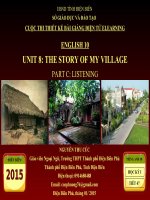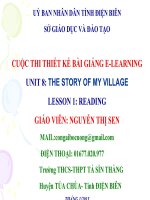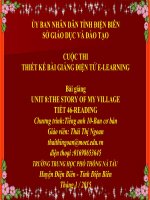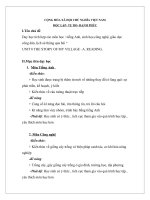Giáo án Tiếng Anh 10 Unit 8: The story of my village
Bạn đang xem bản rút gọn của tài liệu. Xem và tải ngay bản đầy đủ của tài liệu tại đây (250.15 KB, 33 trang )
Giáo án Tiếng Anh 10
A- READING:
Class
Teaching date
Absentees
10A2
I. OBJECTIVES
1.Knowledge
General knowledge: Students learn about life in the country
Language
New words: Words related to country life
2.Skills:
Reading for gist and for specific information
II. METHOD: Integrated, mainly communicative
II. TEACHING AIDS: Textbook and pictures
III.
PROCEDURE
Teacher’s Activities
Student’s Activities
Warm-up (4 mn)
Teacher shows pictures of the countryside Group work make a list of words
and ask Ss to make a list of words related related to the country
to the country.
Ss work in group of 3 or 4
(The group with the longest list will be
the winner.)
T declares the winner
BEFORE YOU READ (10’)
Teacher has students sit in pairs and
discuss the questions in the books.
Students do the task.
Ss work in pairs
Calls some Ss to read their answer aloud Suggested answers
in front of the class.
1.The farmers are harvesting the crop.
Feedbacks and gives suggested answers.
2.They are working very hard.
Some simpler questions can be used:
3.It’s a bumper/good crop.
What do you see in the picture?
4. Good farming methods, good
Who are they?
varieties, modern technology used,
What are they doing?
Presents new words
people work hard.
Ss follow the teacher’s steps
Ss take notes
New words:
-straw (n) rôm
-mud(n) bùn
-technical high school (n) trường
WHILE YOU READ: (20 mn)
Set the scene
You are going to read a passage about
life changes in the country . Just read it
and do the following tasks.
trung học kó thuật dạy nghề
- farming method (n) phương pháp
canh tác
- brick house (n) nhà ngói
- thanks to ( prep) nhờ có
Asks Ss to match the words in A with
their definitions in B.
Encourages Ss to guess the meanings
of the words in the context
Listen
Class organization: Students sit in
Teacher walks around the class and pairs.
offers ideas and comments when
students need help. Then teacher
selects some students at random to
Task1- Vocabulary matching
explain their answers in front of the
Match the words in A with their
class.
definitions in B.
Makes necessary corrections
Students do the task in pairs.
Correct answers:
1.b ( have just enough money to pay
Teacher has students scan the text again the things that you need)
and get the information to complete the
table.
2.d( having to have many things that
Lets Ss study the table carefully before
doing the task.
you do not have )
3.a ( making one’s life better )
Goes around the class and provide help 4.e( good crops)
when necessary.
5. c ( crops to be sold , not for use by
Tells Ss to discuss the answer with a the people who grow it )
friend.
Task2.Table completion
Checks the answers in front of the class as
a whole.
scan the text again and get the
information to complete the table.
Individual work
Correct answers:
Areas
Before
houses
Made of Made
straw
Now
of
bricks
and
mud
Radio/TV Few
Many have
families
had
Asks Ss to work in pairs. Get the Ss to
Farming
read the passage again and answer the
methods
questions in Task3
Has
Sts compare their answer with
crops
old
new
poor
Good/bumper
another pair.
travel
By motorbike
Calls some Ss to read their answers aloud
in front of the class.
Task3-Answering questions
Gives feedback.
Read the passage again and answer
the questions in Task3
Work in pairs then compare their
answer with another pair.
Correct answers:
1 It was poor and simple.
2 Because they hope that with an
education of science and technology
their children could find a way of
bettering their lives.
3 They introduced new farming
methods which resulted in bumper
crops. They also helped grow cash
crops for export.
4 He said their lives had changed a
lot thanks to the knowledge their
children had brought home.
Post-reading (12 mn)
5 He told his grandchildren ”Study
harder so that you can do more for
Asks Ss to work in pairs and discuss the the village than your parents did.
question:
Students work in pairs.
How can people with an education help
make the life of their community better?
Clarify some terms like
People with education refers to people
with a university study
Suggested answers
Tells Ss to look back at the passage to get Introduce new farming methods.
the idea for the questions.
Grow crash crop s for export.
Goes to groups and provide help when Help local people apply modern
necessary.
technology in farming.
Teacher gives suggestions and comments. Help community especially young
Teacher suggests students’ homework:
people
access
to
ways
of
entertainment
Comments (2 mn)
Raise people’s awareness about food
safety and environmental hygiene
HOMEWORK:
speaking-U8
V. EXPERIENCE:
Prepare
the
B - SPEAKING :
I.OBJECTIVES
1. Education aims: - Students know about plan to improve life of a village and
their possible results.
2. Knowledge:
a. General knowledge: - Students can talk about plans and results.
b. Language:
- "Should" and conditional sentences type 1
- Vocabulary on the plan to improve life of a village.
3. Skills: - Speaking about plan and results.
- Discussing plans to improve life in the village.
II. METHOD: Integrated, mainly communicative
III. TEACHING AIDS:
Textbook, chalk, board.
IV. PROCEDURE:
Teacher’s activities
1. Warm-up( 5 mins)
Asks Ss to work in groups and make a
Students’ activities
list of ideas of their own that can be - Students work in pairs.
carried out to improve the village life.
Teacher walks around the class and
offers ideas and comments when students
need help…
- Listen to the teacher.
- Listens and gives remarks and marks.
2. Before you speak: (10 mins)
Aims: Sts can match each of the plan to
improve life in the village with its - Listen to the teacher.
possible result.
The village of Ha Xuyen are discussing
plans to improve life in the village.
Match the plans with possible results.( 10
minutes)
+ Task 1:
- Explains some new words:
- Listen and take notes.
+ resurface (v ):put new surface on,
renew
- Asks sts to do the task in pairs and give + widen (v )
explanation for their answers
+ canal (n): man-made waterway for
- Asks some sts to read the answers in irrigation
front of the class.
- Gives the correct answers.
3. While you speak: ( 10 mins)
+ muddy(a ): full of mud
- Work in pairs.
Aims: Sts practice discussing the plans
to improve the life in the village and the
possible results.
The villagers are discussing their plans. Asks sts to work in groups using
conditional type 1 and "should".
- Read the answers aloud in front of
the class.
1. b
2. g
4. e
5. f
3. d
6. c
- Explains Conditional sentence type 1 + Task 2:
and should:
- Asks sts to practise the conversation in - Read the conversation in the
the textbook.
textbook.
- Asks some groups to practice the Read and practice the conversation in
conversation in front of the class.
groups of three.
- Listen to the T
- Listen and take notes.
If + S + V(present tense), S +
will/can/may + V
( to talk about something that will or
4. After you speak: ( 14 mins)
Continue the conversation, using the
is likely to happen in the future)
E. g.: If the roads are widened, cars
ideas in table in Task 1. Add some more and lorries can get to our village.
possible if you like
Should or shouldn’t: to give
- Asks sts to work in groups and continue opinions about what is the best thing
the conversation.
to do.
+ Task 3:
- Writes the main phrases on board and
ask sts to look at these phrases to practice
their conversation.
- Work in groups of three.
-
Some
groups
practice
the
conversation in front of the class.
- medical center
- cash crops
health
export,
money
- Goes around to help sts if necessary.
- bridge
shorter
Sts may add their own ideas in the way to town
conversation.
- football ground
play sports,
exchange ideas.
- Work in groups and add some their
own ideas.
- Some groups present in front of the
class.
A: I think we should build a football
ground, too.
B: I agree with you. If a football
ground is built, young people can play
sports in the free time.
C: A football ground is also a place
where people can meet and exchange
ideas.
A: What about a medical centre? I
think it’s necessary to build a medical
centre.
B: Yes. If a medical center is built,
People’s health will be looked after
better.
C: Yes. And if we get sick. we won’t
have to go to the provincial hospital
-
Comments
and
gives
necessary
for treatment.
corrections.
5. Homework: ( 1 min)
HOMEWORK:
Write a passage about plans to improve Write a passage about plans to
the life in the area where you live.
improve the life in the area where you
live.
V. EXPERIENCE:
C. LISTENING:
I. OBJECTIVES:
1. General knowledge:
- Sts know the changes in a small town on the South coast of England.
2. Language:
- The past tense: used to
- The passive voice
- Vocabulary on villages.
3. Skills: - Listening: choose True/ False statements, fill in the gaps with one
suitable word, answer the questions
- Speaking: Discuss the changes in sts' hometown/ home village
II. METHOD: Integrated, mainly communicative
III. TEACHING AIDS:
- Textbook , tape
IV. PROCEDURE:
Teacher’s activities
Students’ activities
1. Warm up:(7 min)
* GAME: Find someone who
Did you use to…?
name
-
Prepares a two-column table with
Have a favourite toy
Yes/ No questions and Name.
when you were a
- Lets Ss go around the class and ask
child?
other Ss what they used to do when
Have a nickname?
they were small. If the answer is
Have a pet?
Yes, write his/her name in the table.
Cry at night when
(the winner is the first one who
you were a child?
completes the name column)
Hate school?
Play hide-and-seek?
2. Before you listen:(10 mins)
Aims:to focus sts on the topic and
- Work in groups to ask and compare
the two pictures.
review/ introduce the words and
phrases used in the listening text.
a. Focus sts on the two pictures in the
textbook and asks sts to work in
groups to compare them to see the
changes of the town following the
model in the book.
E.g.: - There didn't use to be any hotel
in the town
- There used to be small houses
- Cows used to graze in the field
- Some sts stand up and give their
answer.
Sts copy the words and phrases.
- Listen and repeat.
- Read the words in pairs and correct
........................................
each other’s mistakes.
- Asks some sts to give their answer.
- Some individuals read the words
aloud.
b. Introduces some new words
- Reads the words and ask sts to
- atmosphere (n): kh«ng khÝ
repeat.
- resurface(v): tr¶i l¹i ( mÆt ®êng)
- Asks sts to read the words in pairs.
- turn into (v): trë thµnh
- Asks some sts to read the words + Task 1:
again.
- Listen to the T.
3. While you listen:( 17 mins)
Aims:Sts
practise
listening
- Work in pairs to guess if the
and statements are true or false.
marking True/ False statements.
- Listen to the tape and do the task
- Tells sts that they are going to listen
to a talk about the changes in a small
town in England.
- Asks sts to work in pairs, look at the
statements given and guess if they are
true or false.
- Asks sts to listen to the talk and tick
the right column to indicate their
answer
and
underline
the
false
- Compare their answer.
information. T plays the tape twice.
- Asks sts to compare their answer in - Give their answer.
pairs.
- Checks sts’ answer.
1. F It's on the south coast of England.
2. F It's used to be a small quiet town.
3. T
4. F The big trees have been cut down.
5. F Some people don't like the changes
- Plays the tape once again, stop the
tape where necessary and conduct the
correction.
- Check their answer and then correct
their work if they have the wrong
answer.
+ Task 2:
- Work in pairs to read the passages and
Aims:Sts practise listening for specific try to fill in the gaps.
information by filling in the gaps with
ONE word.
- Asks sts to have a look at the
paragraph in the textbook and to read
them in pairs and make sure they
- Listen and do the task.
understand them. T encourages sts
guess the words to fill in the gaps.
- Asks sts to listen to the tape once or
twice again to fill in the gaps with the
missing words.
- Give their answer.
- Asks sts to compare their answer in 1. houses
2. hotel
pairs.
3. widened
4. cut
- Checks sts’ answer.
5. car
6. shop
- Plays the tape once again, stop the 7. department
tape where necessary and conduct the
8. expensive
correction.
- Check their answer and then correct
their work if they have the wrong
answer.
4. After you listen:(10 mins)
- Asks sts to work in pairs and tell
each other about the changes in their
village/ town.
- Work in pairs.
- Moves round to check the activities
and to make sure that sts are working
effectively.
- Asks two sts to present in front of the
-Two sts present.
whole class.
- Checks and gives remarks.
5. Homework:(1min)
Write a short paragraph about the
changes in their village/town
V. EXPERIENCE:
D. WRITING :
I. OBJECTIVES:
1. Education Aims: - Students can write a letter giving directions to a certain
place.
2. Knowledge:
a. General knowledge: - Giving directions.
b. Language:
- Language used to give directions.
- Imperative sentences.
3. Skills: - Reading: read the sample letter.
- Speaking: work in pairs to find Ann's house on the map as well as
the words and phrases used to give directions .
- Writing: write a letter to tell Jim the way to house A on the map.
II. METHOD: Integrated, mainly communicative
III. TEACHING AIDS: - board, textbook, chalk.
IV. PROCEDURES:
Teacher's activities
1. Homework checking :( 5 mins)
- Asks one st to talk about the changes in
Students' activities
our hometown or his/her home village.
- Asks other sts to listen to their friend and
- Listen to their friend and give
give remarks.
remarks.
- Checks and give remarks.
2. Before you write:( 20 mins)
- Aims:to get sts to read the sample letter
and to help them to prepare vocabulary
and information before they write.
- Introduces the situation.
- Explains some new words:
- Asks sts to listen to the teacher and repeat ,
then write these words into their notebooks.
+ Task 1:
- Listen to the teacher carefully.
and take notes
+ direction (n) : the way that a
person or thing moves along
+ enclose (v): put something in a
letter or a parcel
- Listen to the teacher and then read
these words in chorus and
individually.
- Asks sts to work in pairs to read about the
- Read the letter in pairs.
letter and to look at the map to find Ann's
house.
- Moves round to help if necessary.
- Share their answer with their
friends.
- Asks sts to compare their ideas with other
pairs.
- Asks some sts to tell the whole class where
Ann's house is. T may ask them to explain
more about their answer.
- Present their ideas.
Answer: H
- Listens and give remarks.
- Asks sts to work in pairs to read the letter
- Listen to the teacher.
again and underline the words and phrases
+ Task 2:
used to give directions.
- Work in pairs to read the letter and
- Moves round to help if necessary.
undreline the words/phrases.
- Asks 2 sts to write these words/ phrases on
the board.
- Two sts write the words and
- Checks and gives remarks.
phrases on the board
- Asks sts to make some examples with
get out of
these words.
go over ( a bridge)
turn right/left
walk past ( a medical centre)
keep walking
3. While you write:( 10 mins)
take the first/second.....
- Aims: Sts practise writing a letter to Jim,
telling him the way to house A from Roston
Railway Station.
- Asks sts to write a letter to Jim, telling
him the way to house A from Roston
Railway Station.
- Do the writing task.
- Lets sts write in 8 minutes.
- Read their writing: ( a sample
- Moves around to conduct the activity.
paragraph)
"Dear Jim,
4. After you write:( 9 mins)
Aims: to get feedback and check sts' work.
- Gets feedback by asking some sts to read
their work aloud.
- Asks some other sts to give remarks.
- Checks and give the correct answer.
I'm very glad that you will come
here for the summer
holiday ............. from Roston
Raiway Station.
Now when you come out of the
station, turn right. Keep walking for
about 5 minutes, you will see a
small bridge ahead. Go over the
- If there is enough time, T can have sts
bridge, go along the street, walk
exchange their writing among sts within a
past a medical centre and the car
group so that they can check their friend's
park then take the second turning
work and give remarks
on the left. Walk past the Souvenir
5. Homework: ( 1min)
shop and you will see my house. It's
on the right, next to the
- Write a letter to tell their friends the way
from our school to Border Gate.
V. EXPERIENCE:
shop.............. "
E. LANGUAGE FOCUS:
I. OBJECTIVES:
1. Education Aims:
- Students know how to pronounce the sound /aʊ/ and /əʊ/ correctly.
- Students revise reported speech and conditional sentence type 1.
2. Knowledge:
+ Language:
- Pronunciation: /aʊ/ and/əʊ/ .
- Reported speech .
- Conditional sentence type 1.
3. Skills: + Speaking: - Work in pairs to discuss the exercises.
+ Reading: - Read words and sentences aloud.
- Read the sentences silently to do the exercises.
II. METHOD: Integrated, mainly communicative
III. TEACHING AIDS: board, chalk, textbook, cassette player.
IV. PROCEDURES:
Teacher's activities
Students' activities
1. Homework checking: ( 5mins)
- Asks one st to tell the whole class the way
- One st speaks aloud in front of
from our school to Border Gate.
the whole class.
- Asks another st to give remarks.
- Give remarks.
- Checks and give a mark.
- Listen to the teacher.
2. Pronunciation:( 10 mins)
- Aims: to introduce three sounds /aʊ/ and
/əʊ/ and help sts to practise these sounds.
a. Writes two sounds on the board and
pronounce them clearly twice, then ask sts to
repeat.
- Write down two sounds.
- Tells sts how to pronounce these sounds
- Listen to the teacher and repeat.
accurately.
- Look at the book , listen and
- Asks them to look at the textbook, listen and repeat.
repeat.
- Then asks sts to work in pairs to read the
words again so that they can check for each
other.
- Moves around to help .
- Asks two sts to read again and give remarks.
b. Asks sts to look at sentences in page 89 in
the book.
/aʊ/
/əʊ/
cow
coat
town
phone
how
bone
...........................
- Read these words in pairs and
check for their partners.
- Asks them to work in pairs to read the
sentences and then find out the words
containing sound /aʊ/ and sound /əʊ/ .
- Asks them to work in 2 minutes.
- Moves around to conduct the activity.
- Asks one st to report and other sts to give
remarks.
- Checks and give the correct answers.
- Asks some sts to read these sentences aloud.
- Listens and give remarks.
3. Grammar: ( 29 mins)
- Look at the book and work in
pairs.
- Answers:
/aʊ/
/əʊ/
shout
rose
loudly
snow
ours
over
...............................
- Read the examples.
Aims: to revise the reported speech and
conditional sentence type 1 and have sts do
Ex1, EX 2, EX3and EX4.
a. Reported speech: Statements
- Recalls the use of reported speech: to report
what someone has said. No quotation marks
are used and some parts of speech have to be
changed.
- Gives an example:
- Asks sts to read the example and think about - Listen to the teacher.
the changes when we turn a sentence into









